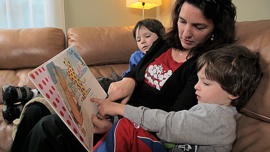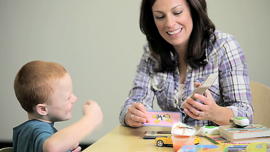Reading to toddlers
How do you read to a squirmy toddler? LeapFrog Literacy Expert Dr. Carolyn James has help for parents of toddlers who won’t sit still!
It’s impossible to deny the powerful bonding moments created as you read to your toddler, and studies show that reading aloud to your child is the most important thing you can do to help build the skills for future reading success. As children listen to books read aloud, they are building vocabulary, learning about the sounds and rhythms of language, and developing a sense that reading is an enjoyable, worthwhile activity that fosters imagination and creativity.
All that said, we know that toddlers like to move! So here are a few key things to keep in mind as you encourage your wiggly toddler to be more engaged in the read-aloud experience.
Act out stories
Make reading fun. The more engaging the reading experience, the better. Make story books come to life by giving characters different voices and adding drama to the narration; when a character acts surprised or sad, change your tone to express the emotion. You want your children to realize that, beneath the surface of the text, there is a great story filled with imagination.
Read a variety of fiction & nonfiction books
Make sure you have plenty of books available that build on your child’s interests. If your child loves animals or trains or princesses, make sure you have books that mirror these passions. Be sure you offer both storybooks and nonfiction texts—research has shown that nonfiction texts often prompt even more discussion between parents and children.
Let your child choose the books you read together. Studies have identified a strong link between offering choice and motivation to read.
Let toddlers finish phrases & rhymes
You want kids to interact with the reading material. One way to do this is to read rhyming books and pattern books, or read books with repeating phrases and encourage your child to join in the reading. Read aloud and pause at opportune spots, encouraging your child to join in on the rhyming or patterned portions of text. When they can predict what comes next, young children build confidence and can begin to see themselves as “readers.”
Asking questions will help your child remember what’s been read. Talk about the narrative and ask what he thinks of a character’s decision. What would he do differently? What does he think will happen next? Encourage him to interrupt you if he doesn’t understand a word.
Have your child demonstrate her understanding of the book by pointing to illustrations. For example, ask questions like “Can you point to the bear that looks worried?” “Where was the wolf hiding before he crossed the road?”
Remember the goal of your shared reading time is to foster a love of reading while helping your toddler appreciate and understand what is read.













